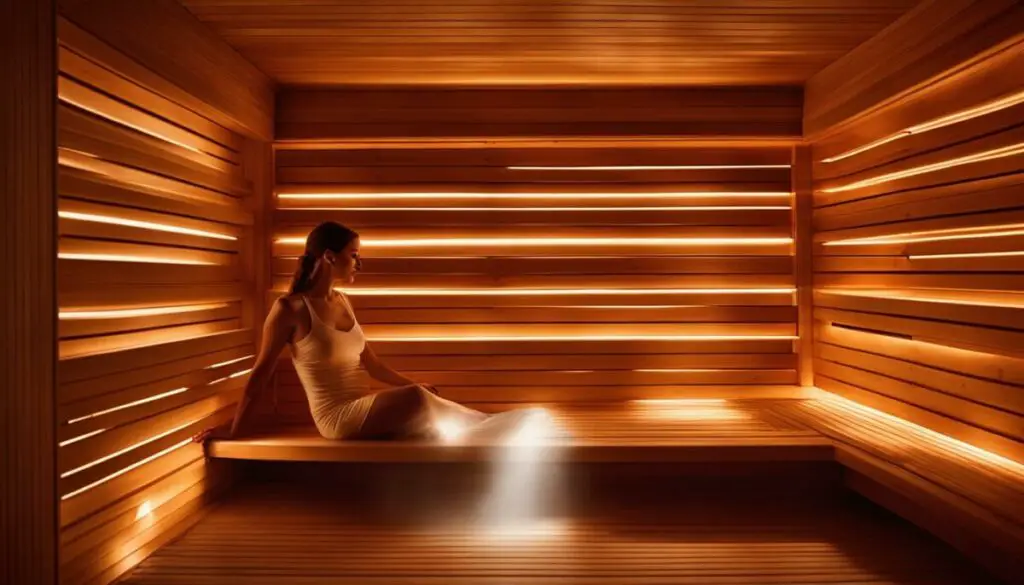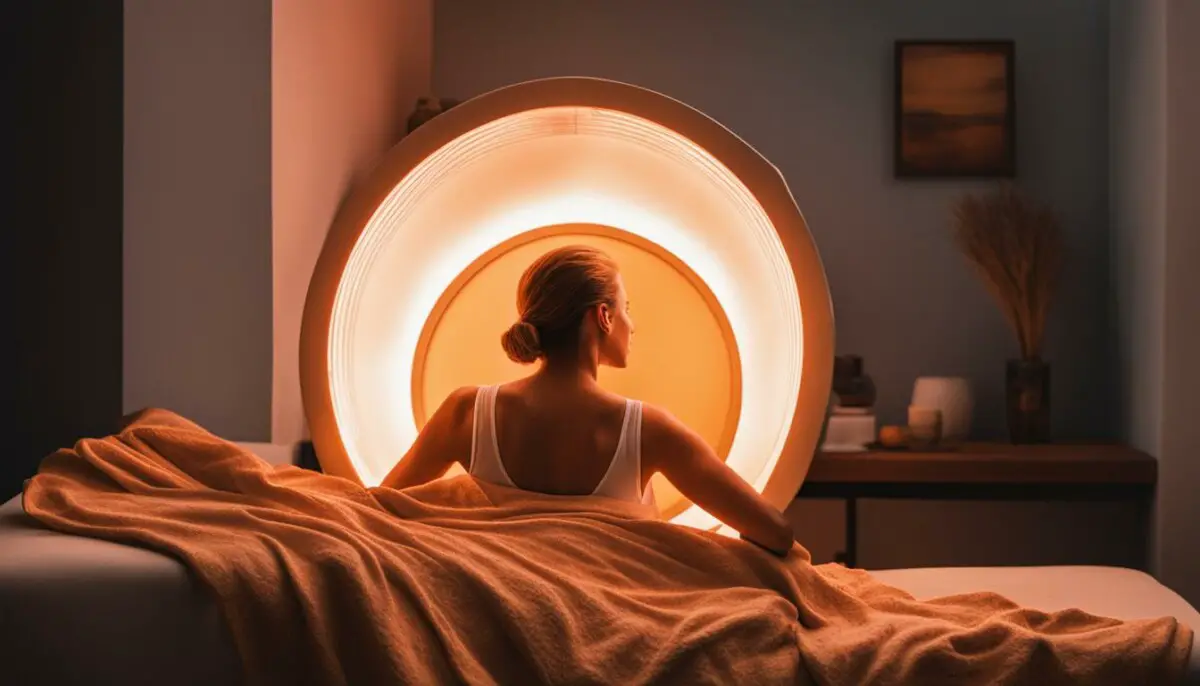Last Updated on 6 months by Francis
With the rise of infrared therapy and saunas, many have started to question whether these alternative methods of light therapy can help with vitamin D production and absorption. Vitamin D is a crucial nutrient that helps our body absorb calcium and supports bone health, immune function, and overall well-being. In this section, we will uncover the potential benefits of using infrared light for enhancing vitamin D levels in the body.
Contents
Key Takeaways:
- Infrared light therapy has gained popularity for its numerous health benefits, including potentially assisting with vitamin D production and absorption.
- Vitamin D is an essential nutrient that supports bone health, immune function, and overall well-being.
- Using infrared therapy, saunas, and lamps may be beneficial for enhancing vitamin D levels, but more research is needed to fully understand the extent of their benefits.
- It’s crucial to consult with healthcare professionals for personalized advice on managing vitamin D deficiency or supplementation.
Understanding Vitamin D and Its Importance

Vitamin D is a fat-soluble vitamin that plays an essential role in maintaining overall health. It is responsible for the absorption and regulation of calcium and phosphate in the body, which are essential for bone health and growth. In addition, it also contributes to a healthy immune system and may have a role in preventing chronic diseases such as diabetes and heart disease.
Vitamin D is synthesized in the skin through exposure to ultraviolet B (UVB) radiation from the sun. This process, known as vitamin D synthesis, is dependent on several factors, including the time of day, latitude, season, and skin pigmentation. Vitamin D can also be obtained from certain foods, such as fatty fish and fortified dairy products.
Despite the importance of vitamin D, many individuals may be deficient due to limited sun exposure, dietary restrictions, or underlying medical conditions. Vitamin D deficiency can lead to a range of symptoms, including fatigue, muscle weakness, and bone pain. In severe cases, it can result in rickets in children and osteoporosis in adults.
Synthesis of Vitamin D
Vitamin D synthesis occurs when the skin is exposed to UVB radiation from the sun. When this occurs, a molecule in the skin called 7-dehydrocholesterol is converted into vitamin D3. This form of vitamin D is then transported to the liver, where it is converted into 25-hydroxyvitamin D (25(OH)D), the major circulating form of vitamin D in the body. From there, it is transported to the kidneys where it is further converted into the active form of vitamin D, known as calcitriol.
Factors Affecting Vitamin D Production and Absorption
Several factors can affect vitamin D production and absorption in the body. These include:
- Sun exposure: The amount of UVB radiation, time of day, season, and latitude can all impact vitamin D synthesis.
- Skin pigmentation: Individuals with darker skin require longer sun exposure to produce the same amount of vitamin D as those with lighter skin.
- Diet: A diet low in vitamin D-rich foods can contribute to deficiency.
- Age: As individuals age, their skin becomes less efficient at producing vitamin D.
- Medical conditions: Certain medical conditions, such as liver or kidney disease, can interfere with vitamin D production and absorption.
Given the importance of vitamin D for overall health and the numerous factors that can affect its production and absorption, it’s important to explore potential strategies for enhancing vitamin D levels in the body. This is where the potential benefits of infrared light come into play.
How Does Infrared Light Work?

Infrared radiation is a type of electromagnetic radiation that exists beyond the visible spectrum. It is a form of energy that is emitted by objects and can be absorbed by other materials. Infrared light has a longer wavelength than visible light, which means it is less energetic and produces less heat.
Infrared therapy involves using infrared lamps or saunas to generate heat that is absorbed by the body. The heat is thought to stimulate cellular repair, increase circulation, and promote relaxation.
Infrared saunas, in particular, have become increasingly popular in recent years due to their numerous health benefits. These saunas use infrared lamps to heat the body directly, rather than heating the surrounding air like traditional saunas.
Some of the benefits of infrared therapy and saunas include:
- Reduced inflammation
- Improved circulation
- Relaxation and stress relief
- Pain relief
- Detoxification
While more research is needed to fully understand the mechanisms behind these benefits, it is clear that infrared light and therapy can have a positive impact on overall health and well-being.
In the next section, we will explore the relationship between infrared light and vitamin D production.
The Relationship Between Infrared Light and Vitamin D Production

Scientific research suggests that infrared light exposure may enhance vitamin D production in the body. According to a study published in the Journal of Clinical Endocrinology & Metabolism in 2011, infrared light exposure was found to increase vitamin D levels in participants who were deficient in the vitamin at the start of the study.
The same study also found that participants who were exposed to infrared light for longer periods experienced a greater increase in vitamin D levels. This suggests that the duration of exposure to infrared light may play a role in its impact on vitamin D synthesis.
Infrared lamps are another potential tool for enhancing vitamin D production. Infrared lamps emit infrared radiation, which has been shown to penetrate the skin and stimulate vitamin D synthesis. While more research is needed to determine the optimal length and intensity of exposure required for maximum benefits, infrared lamps may offer a convenient and effective alternative to sunlight exposure for individuals with limited sun exposure.
Different Types of Infrared Lamps
There are various types of infrared lamps available, each with different wavelengths and intensity levels. Some of the most commonly used infrared lamps for vitamin D production include:
| Lamp Type | Wavelength | Intensity |
|---|---|---|
| Near-infrared (NIR) lamps | 700-1400 nm | Low |
| Intermediate-infrared (IR-A) lamps | 1400-3000 nm | Medium |
| Far-infrared (IR-C) lamps | 3000-10,000 nm | High |
NIR lamps are the most widely used for medical and therapeutic purposes, including vitamin D production. While they have low intensity, their shorter wavelength penetrates the skin more deeply than longer-wavelength IR-A and IR-C lamps.
“Infrared lamps emit infrared radiation, which has been shown to penetrate the skin and stimulate vitamin D synthesis.”
Individuals who are considering incorporating infrared lamps into their routine should consult with a healthcare professional to determine the appropriate type and duration of exposure based on their unique needs and medical history.
Infrared Therapy and Vitamin D Levels

While spending time in the sun is the most popular way to boost vitamin D levels, infrared therapy may offer a viable alternative. Infrared heat can penetrate the skin deeply, raising the body’s core temperature and increasing blood flow. This process can stimulate the body’s natural production of vitamin D, leading to enhanced vitamin D levels.
Infrared therapy has been shown to improve vitamin D absorption in several ways. Firstly, the increased blood flow caused by infrared heat can enhance the delivery of nutrients to the body’s tissues, including vitamin D. Furthermore, infrared heat can widen the blood vessels, allowing for more efficient transport of vitamin D to the target cells.
Studies have also shown that infrared therapy can be a beneficial adjunct for individuals with vitamin D deficiency. In one study, participants with low vitamin D levels who underwent infrared treatment demonstrated an increase in vitamin D levels after just three weeks of treatment. Infrared therapy may be particularly useful for individuals who have limited sun exposure or are unable to take vitamin D supplements.
However, further research is needed to fully understand the potential benefits of infrared therapy for enhancing vitamin D levels. It’s crucial to consult with healthcare professionals for personalized advice on managing vitamin D deficiency or supplementation.
The Benefits of Infrared Saunas for Vitamin D Synthesis

Infrared saunas have become increasingly popular in recent years for their array of health benefits, including improved skin health, relaxation, and detoxification. However, did you know that spending time in an infrared sauna may also boost vitamin D synthesis?
While traditional saunas use heat to warm the air around you, infrared saunas use infrared rays to heat your body directly. This heat penetrates deeper into your skin and tissues, causing you to sweat at a lower temperature than traditional saunas.
One study conducted in 2018 investigated the impact of infrared sauna use on vitamin D levels in men. The results showed a significant increase in vitamin D levels after just one session, with continued use leading to even greater improvements.
In addition to enhancing vitamin D synthesis, spending time in an infrared sauna can also provide other benefits for overall health and wellness. These may include:
- Improved circulation
- Reduced inflammation
- Enhanced immune function
- Stress relief
If you’re interested in incorporating infrared sauna use into your routine for its potential vitamin D benefits, be sure to speak with your healthcare provider first to ensure it’s safe for you.
“Infrared sauna therapy is an effective and convenient means of improving vitamin D status while providing all the other health benefits associated with sauna use.”
The Role of Infrared Heat in Vitamin D Absorption

When it comes to maintaining optimal vitamin D levels, exposure to sunlight is often considered the primary source. However, infrared heat may also play an essential role in vitamin D synthesis and absorption.
Research has shown that infrared radiation can penetrate the skin and stimulate the body’s production of vitamin D through a process similar to sunlight exposure. This suggests that infrared heat may act as a viable alternative for individuals who have limited access to sunlight or who struggle with vitamin D deficiency.
Furthermore, infrared therapy may enhance the body’s ability to absorb and utilize vitamin D through its effects on blood circulation and metabolic function. By increasing blood flow to the skin and muscles, infrared heat can enhance the delivery of nutrients, including vitamin D, to various parts of the body.
While more research is needed to fully understand the mechanisms underlying the relationship between infrared heat and vitamin D absorption, initial studies are promising. Incorporating infrared therapy strategies, such as infrared saunas or lamps, into one’s routine may be a beneficial adjunct to maintaining optimal vitamin D levels.
“Research has shown that infrared radiation can penetrate the skin and stimulate the body’s production of vitamin D through a process similar to sunlight exposure.”
Other Factors Affecting Vitamin D Levels

While infrared light exposure can be a helpful method for enhancing vitamin D levels, it’s important to consider other factors that can impact vitamin D absorption in the body.
Diet: Research has shown that diets low in vitamin D can contribute to vitamin D deficiency. Foods such as fatty fish, cheese, and egg yolks contain vitamin D and can contribute to maintaining optimal vitamin D levels. Additionally, consuming foods fortified with vitamin D, such as milk and cereal, can also help increase vitamin D intake.
Age: As we age, our skin becomes less efficient at producing vitamin D through sunlight exposure, which can contribute to lower vitamin D levels. Older adults may need to spend more time outdoors or use vitamin D supplementation to maintain sufficient levels.
Skin Pigmentation: Melanin, the pigment that gives skin its color, can reduce the skin’s ability to produce vitamin D. Individuals with darker skin may require longer periods of sunlight exposure to maintain healthy vitamin D levels.
Geographical Location: People who live in areas with limited sunlight exposure, such as northern latitudes during the winter months, may have difficulty obtaining vitamin D through sunlight exposure alone.
To ensure optimal vitamin D levels, it’s important to consider these factors and take the necessary steps to maintain healthy vitamin D levels through a combination of sunlight exposure, diet, and supplementation as needed.
The Importance of Vitamin D Supplementation
While infrared light therapy may show potential benefits for enhancing vitamin D levels, supplementation remains crucial to maintaining optimal vitamin D levels. Vitamin D supplementation can help individuals who may have limited exposure to sunlight or struggle with vitamin D deficiency.
According to a report by the National Health and Nutrition Examination Survey (NHANES), vitamin D deficiency affects nearly 50% of the U.S. population.
Supplementation can be particularly important for individuals who are at higher risk for vitamin D deficiency, including those with darker skin, older adults, individuals with limited sun exposure, and those with conditions that affect vitamin D absorption. Consultation with a healthcare professional can help determine the appropriate vitamin D supplementation dosage for individual needs.
| Factors affecting vitamin D levels | Solutions |
|---|---|
| Age | Vitamin D supplementation |
| Dietary habits | Vitamin D-rich foods and supplementation |
| Skin pigmentation | Vitamin D supplementation and increased sun exposure |
| Geographical location | Vitamin D supplementation and increased sun exposure (especially during winter months) |
Vitamin D supplementation is an effective way to maintain optimal vitamin D levels and promote overall health. Combined with a healthy diet and appropriate sun exposure, vitamin D supplementation can make a significant impact on maintaining healthy vitamin D levels.
Conclusion
After a thorough exploration of the relationship between infrared light and vitamin D, it is evident that incorporating infrared therapy strategies can potentially assist in vitamin D production and absorption. While more research is required to fully understand the extent of their benefits, using infrared therapy, saunas, and lamps in conjunction with maintaining a healthy diet and adequate sunlight exposure may be beneficial in maintaining optimum vitamin D levels in the body.
It is essential to seek personalized advice from healthcare professionals about managing vitamin D deficiency or supplementation. While infrared therapy has the potential to aid in vitamin D production and absorption, it cannot replace vitamin D supplementation in individuals with a deficiency.
Overall, it remains an exciting area of study, and more research is required to determine the full extent of the impact of infrared therapy on vitamin D levels in the body. However, given its benefits for other aspects of health, incorporating infrared therapy into a wellness routine may have numerous health benefits.
Thank you for reading! We hope this article has helped to uncover the potential benefits of infrared therapy for vitamin D deficiency.
FAQ
Does infrared help with vitamin D?
While infrared light therapy has shown potential benefits for enhancing vitamin D production, more research is needed to fully understand its effectiveness. It is important to consult with healthcare professionals for personalized advice on managing vitamin D deficiency or supplementation.
What is the role of vitamin D in the body?
Vitamin D plays a crucial role in various bodily functions, including bone health, immune system function, and calcium absorption. It is synthesized through sunlight exposure and can also be obtained through certain foods or supplements.
How does infrared light work?
Infrared light is a type of electromagnetic radiation that is invisible to the human eye. It is absorbed by the skin and tissues, producing heat and potentially stimulating various biological responses within the body.
Is there scientific evidence supporting the connection between infrared light and vitamin D production?
While some studies suggest that infrared light exposure may enhance vitamin D synthesis in the body, more research is needed to establish a definitive link between the two. It is always important to consult with healthcare professionals for personalized advice.
Can infrared therapy help with vitamin D deficiency?
Infrared therapy has the potential to enhance vitamin D absorption and may be a beneficial adjunct to managing vitamin D deficiency. However, it is important to seek guidance from healthcare professionals to determine the most appropriate treatment plan.
What are the benefits of using infrared saunas for vitamin D synthesis?
Infrared saunas have gained popularity for their numerous health benefits, but their specific impact on vitamin D synthesis is still being studied. Spending time in an infrared sauna may potentially stimulate vitamin D production in a manner similar to sunlight exposure. However, more research is needed to fully understand this relationship.
Can infrared heat be an alternative to sunlight exposure for maintaining optimal vitamin D levels?
Infrared heat has shown potential for enhancing the body’s ability to synthesize and absorb vitamin D. While it may offer an alternative to sunlight exposure, further research is needed to determine its effectiveness. It is always advisable to consult with healthcare professionals for personalized advice on managing vitamin D levels.
What are some other factors that can affect vitamin D levels?
Vitamin D absorption can be influenced by factors such as diet, age, skin pigmentation, and geographical location. It is important to consider these factors in addition to any potential benefits of infrared light therapy for maintaining optimal vitamin D levels.
Is vitamin D supplementation necessary?
While infrared light therapy may have potential benefits for enhancing vitamin D levels, supplementation remains a crucial aspect of maintaining optimal vitamin D levels, especially for individuals with limited sunlight exposure or vitamin D deficiency. It is important to consult with healthcare professionals for personalized advice on supplementation.
What is the conclusion regarding the relationship between infrared light and vitamin D?
Infrared therapy, saunas, and lamps have shown potential for assisting in vitamin D production and absorption. However, more research is needed to fully understand the extent of their benefits. Incorporating infrared therapy strategies into a routine may be a beneficial adjunct to maintaining vitamin D levels, but it is crucial to consult with healthcare professionals for personalized advice on managing vitamin D deficiency or supplementation.









